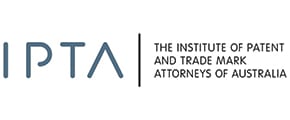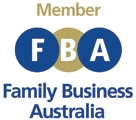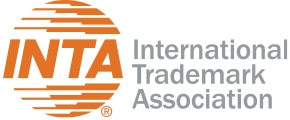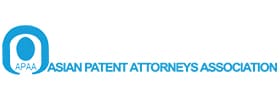Australian & International Trade Mark Protection Services
Trade Mark Preparation Lodgement Examination Opposition Monitoring Licensing Enforcement
Simplify Your Success – Let Wynnes take the complexity out of IP protection
Our Trade Mark Attorneys are available for a free consultation. We are happy to discuss your situation with you in person, over the phone, or online.

The Commercial Benefits Of Trade Mark Protection
What is a Trade Mark?
A trade mark is a sign used or intended to be used in the course of commerce to distinguish the goods or services by a person from the goods or services of another. A trade mark may be a word or words, brand, logo, graphic, icon, shape, colour, sounds, scents and even different aspects of packaging.
A trade mark serves to identify the origin of particular goods or services with a trader enabling the trader to benefit from the reputation and goodwill associated with the trade mark.
A common misconception is that registration of a business name confers property rights in the name. It does not!
The requirement to register business names is consumer-focused legislation to assist people who are dealing with a business to identify the principals of the business.
If a business name is being applied to goods or being used to indicate services, it is being used as a trade mark and a separate application for its registration as a trade mark should be considered. The trade mark registration will then confer the exclusive right to use that mark in relation to those specific goods or services throughout Australia.
Please Be Aware
The following assets DO NOT provide protection of a brand or business name:
Registration of a Trade Mark provides the owner with proprietary rights in the mark. This means:
- No other person or entity is allowed to use the registered mark without the owner’s authorization throughout Australia or any country that the trade mark is registered for the goods or services protected by the trade mark;
- Avoids the need to establish Passing Off of an unregistered trade mark in costly court proceedings;
- Prevents the registration of a subsequently filed substantially identical or deceptively similar trade mark;
- Alerts competitors and others that the trade mark is protected from unauthorized use;
- The registration can be included in the balance sheet for business valuation purposes;
- The registration can facilitate the franchising and licensing of a business;
- The registration provides a defense against infringing other trade mark registrations.
Choosing a Trade Mark
In order for a trade mark to be registered it must satisfy a number of statutory requirements including:
- A trade mark must be inherently and or factually distinctive in relation to the particular goods or services for it to be registered. A trade mark is considered inherently distinctive if it is a sign that other traders with similar goods or services would not wish to use to describe their goods or services. A trade mark is factually distinctive if the trade mark has been used by a trader to the extent that consumers associate the trade mark with the trader and their particular goods or services and not with some other business.
- A trade mark must not be substantially identical or deceptively similar to a pending or currently registered trade mark on the trade mark database in order for it to be registered.
- A trade mark preferably does not include a geographical name where the business is or could be carried out; directly descriptive words such as STAY SHARP for knives; and fashionable words such as ECO, ENVIRO, GREEN, OZONE, and “e” for electronic.
- A trade mark which is also a surname is usually not registrable unless it appears less than 500 times on the Australian Electoral Role.
- A domain name may be registered as a trade mark where the identifier satisfies the statutory requirements. The standard address code material such as “http://”, “www”, “net”, “org”, “com”, “au” are not considered distinctive elements.
- Only the owner of the trade mark can register the trade mark. The owner is the person who is the first to use the trade mark in Australia or their successor in title.
- A trade mark can not be registered where the mark is a name that is registered with the Plant Breeders Rights Act.
Applying for Registration of a Trade Mark in Australia
In order to register a trade mark on your behalf, we require:
- The name and address of the applicant. The applicant can be a natural person or a legal person such as a company but not a trust.
- A copy of a representation of the trade mark.
- A list of the goods and or services associated with the trade mark. We recommend also including goods and or services that are intended to be associated with the trade mark in the future thereby avoiding the need to file a further application to cover the new goods or services.
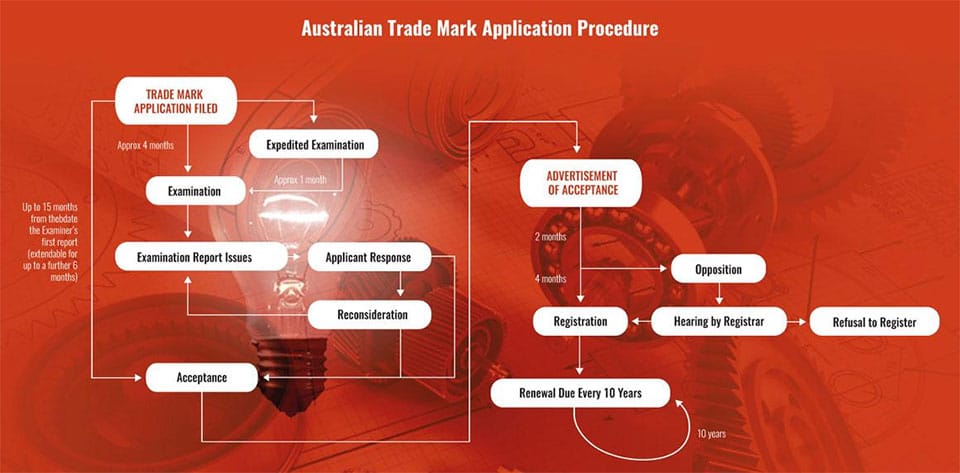
Goods and services are divided into 45 classes in accordance with an international classification system. A trade mark can be registered in respect of goods or services in one or more classes.
From the provided information we will initially conduct an exact mark search to determine whether the same trade mark is the subject of a pending application or a registered trade mark in respect of the same goods or services on the trade mark database.
If an exact trade mark is located we will report the search results and not proceed further with the trade mark application.
If we do not locate an exact trade mark we will prepare the trade mark application and forward a copy of the application for your approval and also report the search results.
We will conduct the exact mark search free of charge if a trade mark application is subsequently prepared and filed. Where a trade mark is not filed we will only charge for conducting the exact mark search. The purpose of the exact mark search is to avoid the needless expense in applying for trade mark registration where the exact trade mark already exists on the trade mark register.
After approval has been provided we will file the application with the Australian Trade Marks Office. The trade mark application is placed in a queue for examination by the Trade Marks Office. Applications are examined in order of lodgment. Examination of a trade mark application can be expedited if required upon application by the applicant. When an application has been examined, the examiner may issue a report raising their objections to registration of the trade mark. Typical objections are that the mark lacks distinctiveness and/or that the registrability of the mark is blocked by the existence of conflicting prior registration or application.
A trade mark applicant has a fee free period of 15 months from the date of the first report within which to overcome objections and obtain acceptance of the application. A further 6 months can be obtained on the payment of monthly extension fees. We therefore recommend that trade mark applications be prosecuted through to acceptance as soon as possible after the first report has issued.
Response to the objections may include legal argument, amendment of the application and or filing evidence in support of registrability.
If the objections have been successfully overcome, the application will proceed to acceptance. After a trade mark application has been accepted, it will be advertised for opposition purposes. The opposition period provides a third party to oppose the registration of the trade mark.
After the opposition period has expired and no opposition proceedings have commenced, the trade mark will proceed to registration upon payment of the registration fee.
The trade mark is registered for a term of 10 years from the filing date. The term can be renewed every 10 years to maintain registration with the payment of renewal fees.
After five years from the date of filing, a registered trade mark is vulnerable to removal for non-use if the trade mark has not been used during a continuous period of three years. If a removal action is initiated by a third party, the trade mark owner must demonstrate that there has been use of the trade mark during this period to maintain the trade mark on the register.
Correct Use of a Trade Mark
It is important that a trade mark is used correctly.
- When the trade mark is used it should always indicate that the word or logo is a trade mark.
If a trade mark has not been registered, it should be marked ™ to indicate that the word is being used as a trade mark.
If a trade mark has been registered, goods should be marked to indicate registration. For example registration can be shown by placing an R in a circle eg. ® or Regd™ next to the relevant trade mark.
It is also advisable to indicate the name of the owner of the trade mark on the goods.
As a cautionary note we point out that it is a criminal offence to represent that a mark is registered in Australia when that it is not. Severe penalties apply for such offences.
- The trade mark should never be allowed to become a generic name for a product or service. A registered trade mark owner should act quickly and effectively to stamp out any unauthorized use of their trade mark. If they do not do this, the trade mark may cease to function as a trade mark and instead become a generic descriptor for a product or service. The registration of a trade mark which becomes generic may be cancelled. The trade mark will then be available for all to use.
Watching and Monitoring Trade Marks
We also provide searching services including clearance searches to determine whether a trade mark can be used in a particular jurisdiction and registrability searches to determine whether a trade markcan be registered in a particular jurisdiction. These searches can be conducted with respect to Australia, New Zealand and any other desired country or region. As stated above, we can with instructions conduct an exact mark search on the Australian or New Zealand trade mark register to determine if the trade mark is already on the register in respect of the specified goods or services before filing a trade mark application.
We can also monitor the progress of a competitor’s trade marks for business purposes.
Understand What You Can Protect With A Trade Mark
Your company’s name and logo are trade marks. Registering these trade marks gives you ownership in respect of your products and services throughout Australia (or other countries).
A memorable slogan or phrase that customers associate with your brand, products, and servicing. (Eg: just do it). New words (Eg: Kodak), unique spelling of a word or alphanumeric combinations (Eg: 7-Eleven).
Icons and Graphics used for computer software or mobile applications serve as distinctive trade marks and are the distinguishing element that potential users identify with a product or service.
The packaging for a product can often be distinctive in how the product is presented to the customer. The customer associates the packaging with the business and provides a quality value to the product.
Advertising jingles or a unique sound associated with your brand (Eg: Windows Start Up) can provide an association with your business, products and services.
Overall shape of a product or packaging (Eg: Coca-Cola bottle) or a particular colour associated with your brand, in your industry (Eg: Cadbury purple).
Different industries such as services relating to plants or wine have unique requirements. With plants, Plant Breeder Rights (PBR) need to be considered. With wine, the Geographical Indications Act must be taken into account.
Register A Trade Mark For Your Business / Brand
There are many benefits of trade mark protection including:
- Setting your business apart from your competitors
- Licensing your competitive advantage as another revenue stream
- Forms part of your marketing and branding messages
- Formally recognising it on your balance sheet as an asset
- Preventing new entrants or competitors taking away/over your hard work
Our IP Australia Trade Mark search and registration service will put you on the right path!
At Wynnes, our team of experienced attorneys can provide a free initial trade mark search help you to navigate the process of registering and managing your trade marks.
How Much Does It Cost To Register a Trade Mark?
The cost for registering a Trade Mark is dependant on how many classes your mark should be protected in.
The cost of registering a trade mark can vary depending on several factors, including the number of classes you’re applying for, the method of application and how many countries you are seeking protection in. Here’s a general overview of the costs involved:
- Application Fees: Official frees start from $250 per class. However, this does not include any pre-assessment or professional knowledge that will increase your chances of getting a registered trade mark that will provide you with a more complete protection and avoid rejections, opposition and removal – for which there are no refunds offered by IP Australia.
Trade mark application with picklist $250 Trade mark application without picklist $400 Trade mark application – additional class $450 Series trade mark application with picklist $400 Series trade mark application without picklist $550 Series trade mark application – additional class $600 - Additional Classes: If your trade mark covers more than one class of goods or services, you’ll need to pay additional fees for each class.
- Renewal Fees: Trade mark registration in Australia lasts for 10 years from the date of filing.
- Professional Fees: If you hire a trade mark attorney or a professional service to manage your application, their fees will be additional. These can vary widely based on the complexity of your trade mark and the level of service provided.
- International Registration: If you want to protect your trade mark outside Australia, you will need to register it in other countries or regions. This will involve additional costs, including international filing fees and should be managed through an Australian Attorney firm.
- Opposition, Hearing, and Other Administrative Costs: If your trade mark application faces opposition or requires a hearing, there will be additional costs. These costs include administrative costs, legal fees, and legal recovery costs (from the opposing side if their opposition is successful).
DIY Trade Mark Applications: Common Mistakes and Risks
- Incorrect Searches: Proper trade mark searches are crucial to determine if a similar mark already exists. DIY searchers may lack the expertise to conduct thorough searches, potentially missing existing marks that could lead to rejection or future legal challenges.
- Misclassification: Trade marks must be registered under specific classes of goods or services. Choosing the wrong class can limit the protection of the trade mark or lead to rejection of the application.
- Inadequate Description of the Mark: A precise and accurate description of the trade mark is necessary. DIY applicants might not describe their mark adequately, which can lead to issues in registration and enforcement.
- Failure to Recognise Complex Legal Issues: Trade mark law can be complex, and DIY applicants may not recognise legal issues or nuances that could affect their application, such as issues with distinctiveness or potential conflicts with existing marks.
- Errors in Application: Mistakes in the application process, such as incorrect applicant details or filing errors, can lead to delays, rejections, or additional costs.
- Lack of Strategic Consideration: Professionals can provide advice on the broader strategy of trade mark protection, including international considerations and long-term planning, which DIY applicants might overlook.
- Risk of Opposition and Litigation: Without professional guidance, the risk of opposition to the application or future litigation might be higher.
- Maintenance and Renewal Issues: Understanding the requirements for maintaining and renewing a trade mark is essential. DIY applicants might miss important deadlines or fail to comply with maintenance requirements.
- Limited Recourse in Case of Mistakes: DIY applicants have limited recourse if they make errors in the application process, whereas professionals often carry insurance for malpractice.
- Potential for Higher Long-Term Costs: If a DIY application is flawed, it may lead to higher costs in the long run, including re-application fees or legal costs if disputes arise.
Given these challenges, it is always advisable to seek professional advice, especially for complex trade marks or when planning to register in multiple jurisdictions.
Trade Mark Infringement, Opposition & Removal
When dealing with trade mark matters in Australia or overseas, understanding the concepts of trade mark infringement, opposition, and removal is crucial. Here’s an overview of each area:
Trade Mark Infringement
- Definition: Infringement occurs when someone uses a sign that is substantially identical or deceptively similar to a registered trade mark for the same or similar goods or services for which the trade mark is registered.
- Consequences: The trade mark owner can take legal action against the infringer, seeking remedies such as damages, an injunction to stop further infringement, and possibly the destruction of infringing goods.
- Defences: Defences against infringement claims can include the use of the sign being outside the scope of the registered trade mark’s goods/services, use in good faith, or that the trade mark should not have been registered (e.g., lack of distinctiveness).
Trade Mark Opposition
- Process: After a trade mark application is accepted by IP Australia, it’s advertised for opposition purposes. During a two-month period, third parties can oppose the registration of the trade mark.
- Grounds for Opposition: Common grounds include the trade mark being similar to an existing trade mark, lack of distinctiveness, the applicant not intending to use the trade mark, or the trade mark being misleading.
- Outcome: If the opposition is successful, the trade mark application may be refused. If unsuccessful, the trade mark proceeds to registration.
Trade Mark Removal for Non-Use
- Grounds for Removal: A registered trade mark may be removed from the Register of Trade Marks if there is no intention to use the trade mark, or if it has not been used in Australia for a continuous period of 3 years from the date it was entered on the Register.
- Process: An application for removal can be filed by any person. The trade mark owner must then oppose the removal action and is then given the opportunity to demonstrate use of the trade mark during the relevant period or to provide reasons for non-use.
- Consequences: If the trade mark owner cannot provide evidence of use, the trade mark may be removed from the register, reducing legal protections for the mark.
Considerations For Trade Mark Infringement, Opposition & Removal
- Professional Advice: Given the complexity of trade mark law, seeking advice from a trade mark attorney or lawyer is often essential, especially in cases of infringement or opposition.
- Monitoring and Enforcement: Trade mark owners should actively monitor for potential infringements and enforce their rights to maintain the strength of their trade mark.
- Record Keeping: Maintaining good records of trade mark use is important, particularly as evidence in opposition or removal proceedings.
This overview provides a basic understanding of these areas. However, trade mark law can be complex, and specific cases may have unique aspects that require professional legal consideration.
Have You Received “Cease and Desist” Notice?
Receiving a cease and desist letter is a serious matter, and how you handle it can have significant implications for your business. Engaging a trade mark attorney ensures that you are making informed decisions and taking the right steps to protect your interests.
It is highly advisable to seek advice from a trade mark attorney if you receive a cease and desist letter for your brand. Here’s why:
- Understanding the Claim: A trade mark attorney can help you understand the specifics of the claim, including whether the other party’s trade mark is valid and enforceable, and whether your brand actually infringes upon their rights.
- Legal Expertise: Trade mark law can be complex and nuanced. An attorney specialising in this area will have the necessary knowledge to navigate these complexities and provide informed advice.
- Assessing the Risks: An attorney can assess the risks associated with the infringement claim, including the potential for legal action, financial implications, and the impact on your brand.
- Formulating a Response: It’s crucial to respond appropriately to a cease and desist letter. An attorney can help draft a response that protects your interests, which might include challenging the validity of the claim or negotiating a settlement.
- Strategic Advice: A trade mark attorney can offer strategic advice on how to proceed, including whether to fight the claim, seek a coexistence agreement, or rebrand.
- Avoiding Escalation: A professional response can help prevent the situation from escalating into a costly legal dispute.
- Future Protection: An attorney can also advise on steps to take to avoid future trade mark disputes and strengthen your brand’s protection
WE ARE PROUD MEMBERS OF
